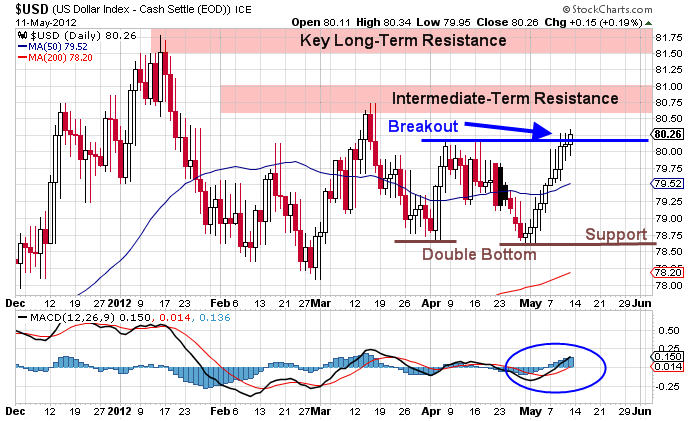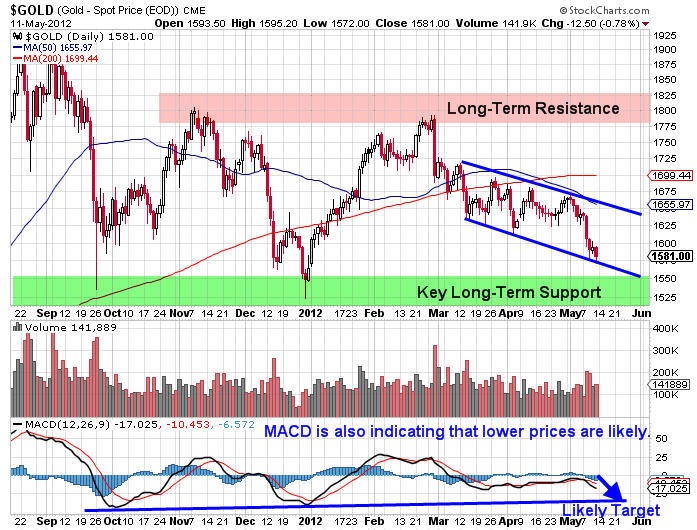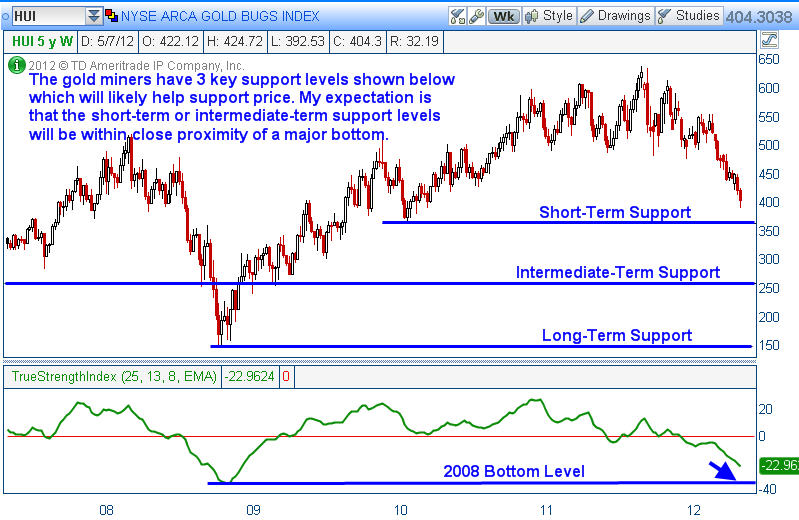Gold & Precious Metals
Gold & Gold Miners Are Closing in on a Major Bottom
Posted by Chris Vermulen - GoldandOilGuy.com
on Monday, 14 May 2012 15:00
“You can’t understand what lays ahead if you don’t understand the past”
~ Satellite, Rise Against ~
Members of my service as well as long time readers know that I do a lot of analysis based on the past. I am constantly looking at long-term historical price charts and data. As a trader, I am always looking for an edge.
Obviously the keys to long-term success involve proper position sizing, risk management mechanisms, and ultimately leveraging probability. Professional traders are masters of these tenets. These characteristics are what separate successful traders from average traders over the long haul.
Sometimes through my rigorous analysis I come across price charts and oscillators that help put together a picture that helps shape my view of the marketplace. The past few months have been some of the most difficult market conditions that I have seen in some time.
The “wall of worries” permeates the financial landscape as risk at present seems unprecedented. The list of macroeconomic concerns ranges from the European sovereign debt crisis to escalation of military action in the Middle East.
I could probably write an entire article about the various risks that plague global financial markets at present, but I try to focus on the positive in any situation. Right now remaining optimistic is a daily battle amid the constant barrage of depressed economic data. Instead of focusing on all of the various risks, I focus on finding opportunities where probabilities are favorable based primarily on historical price data, cycle analysis, and tape reading.
Back on April 9th I proffered an article that discussed my expectation that the U.S. Dollar Index would rally while risk assets such as equities and oil prices would collapse. Additionally I commented on my expectations for weakness in gold, silver, and the entire mining complex. I was wrong about the timing of the U.S. Dollar’s advance, but the ultimate price action analysis was correct.
The following quote came from that article, “As shown above, I believe that short term targets to the downside are likely somewhere in the 1,475 – 1,525 price range. I think gold will find a major bottom near these levels and a strong bounce will play out.” (Click here to view the entire article)
When I originally wrote that article referring to a decline in gold prices gold futures were trading around 1,630 an ounce. Price rallied sharply higher after my article went public, but fast forward to today and my concerns appear to be well founded. I am a long-term gold bull and I ultimately believe that new highs will occur in the future. However, gold and gold miner’s may have further to fall before they find major support.
As stated above, my original expectations for the Dollar Index did not happen in the time frame I was anticipating. However, the belief that a rally was forthcoming proved to be accurate as can be seen from the price chart of the U.S. Dollar Index shown below.

As can be seen above, the price action is confirming serious strength. The weekly close on Friday saw the Dollar close above a key short-term resistance level. Additionally I would point out the double bottom that has been carved out on the chart above which is also bullish. Should resistance near 80.76 give way to higher prices a test of the recent highs is quite possible.
The technical picture suggests higher prices in the near term for the greenback. From a fundamental viewpoint, recent economic data also suggests that higher prices may await as one the largest weekly debt issuance of 2012 among sovereigns within the Eurozone will transpire next week. If any of the debt auctions go poorly it will reflect negatively on the Euro currency and help push the Dollar higher.
Most of the debt issuance is outside of the 3 year maturity window so the LTRO justification to encumber risk does not apply. Next week we will find out just how serious investors are about accepting default risk on European debt instruments. I would be shocked if the ECB sits idly by, but the sheer amount of capital required to safeguard debt issuance next week is extreme, even for a major central bank.
The Euro currency continues to fall and has broken key resistance around the 1.30 price level on the EUR/USD currency pair. Price is not collapsing as of yet, but we are seeing a slow and steady slog lower for the Euro. This price action serves to boost the Dollar which ultimately places downward pressure on risk assets such as equities and oil. Additionally, it reduces the valuation of gold. The daily chart of gold futures is shown below.

The recent price action in gold has been quite ugly and price is resting at key support stemming from an intermediate-term descending channel shown above. Should the lower bound break to the downside a sharp move lower could play out.
It is important to remember that gold is coming off a monster multi-year bull run and it only serves to make sense that a nasty pullback that shakes out the bulls would be forthcoming. I continue to believe that strong support and buyers will come back into gold around the 1,450 – 1,550 price range as significant long-term support levels should hold up prices. The key support zone is clearly illustrated in the chart above.
I continue to wait for price to reach that key support level and based on the current proximity those support levels are magnetizing price toward them. When long-term support / resistance levels are near price a test is a common occurrence. The most important question to ask is whether the support zone shown above will hold, or will even lower prices ultimately play out?
Gold and silver both are starting to become oversold on the daily time frame. While the gold bugs have been feeling pain the past few weeks, the gold miners have been taken out back to the woodshed for a good whipping. The miners have been absolutely crushed in 2012 .
My long term analysis revealed something quite extraordinary on the longer term weekly chart of the HUI gold mining index which I believe is critical for readers to watch and monitor. We are nearing valuation levels based on the true strength index that have not been seen since the market crash that took place back in 2008. The weekly chart of the gold bugs index is shown below.

As can be seen above, the Gold Bugs Index (HUI) has been under considerable selling pressure since early September of 2011. However, note how low the True Strength Index is based on 5 years of price data. We are nearing the same level that we saw back in 2008 which marked a major bottom that ultimately resulted in a monster move to the upside for the gold miners.
I am of the opinion that this chart demonstrates quite clearly that a great buying opportunity for gold, silver, and the miners is likely going to present itself in the near future. I will be watching this price relationship over the next few weeks waiting for a strong entry point for a longer-term purchase. After this pullback concludes, the potential returns that could occur in gold, silver, and the miners could be breathtaking.
With 3 clear support levels, a defined risk approach could be used in order to scale in or to reduce market risk should prices continue to move below each support level. While the time is not right just yet, more than likely a solid long-term risk / reward trade may very well present itself in the precious metals and mining space. I am likely a bit early, but the ultimate end game as it relates to fiat currency is documented throughout history. The final result has a finality that few truly comprehend.
If you enjoyed this article and analysis, you can get our detailed trading analysis videos every Sunday, Monday, Wednesday and Thursday here risk free: http://tradersvideoplaybook.com/risk-free-30-day-trial/
Happy Trading and Investing!
JW Jones & Chris Vermeulen
CHRIS’ NEWSLETTER IS UNLIKE ANY
OTHER ALERT SERVICE
Don’t confuse it with other publications that merely post hypothetical suggested trades, leaving trade management and exits to the subscriber’s discretion.
TheGoldAndOilGuy is the only alert service that allows you to look over the shoulder of a real trader, and profit by copying the ultra-safe, super-accurate trades he is actually trading.
Chris’ approach is so simple … yet so powerful … that anyone can use it to turn their trading account into a consistent, passive income-producing revenue stream. Even if you work a regular full time job Monday – Friday 9-5 you can still take advantage of most the trades because of Chris’ unique trading strategies.
The trades Chris finds enable him and his clients to get the kind of profits most traders only dream about.
And now, this amazing system is available to you, too. Yes, you can change your financial life, starting today, by subscribing to TheGoldAndOilGuy.
This material should not be considered investment advice. J.W. Jones is not a registered investment advisor. Under no circumstances should any content from this article or the OptionsTradingSignals.com website be used or interpreted as a recommendation to buy or sell any type of security or commodity contract. This material is not a solicitation for a trading approach to financial markets. Any investment decisions must in all cases be made by the reader or by his or her registered investment advisor. This information is for educational purposes only.
Tags: Gold Forecast, Gold Trading, Trade Gold

In an April speech in Berlin, Dr. Andreas Dombret, a member of the Executive Board of the Deutsche Bundesbank (the German central bank), offered a startlingly frank assessment of the current problems in Europe. Although his comments were meant to apply to the tensions and imbalances that exist between the northern and southern tier of the 17-member eurozone, they shed inadvertent light on the broader global economy.
Rebuffing calls that Germany do more to support the faltering southern economies, Dr. Dombret said:
…Exchange rate movements are usually an important channel through which unsustainable current account positions are corrected….In a monetary union, however, this is obviously no longer an option. Spain no longer has a peseta to devalue; Germany no longer has a deutsche mark to revalue. Other things must therefore give instead: prices, wages, employment and output.
The question now is which countries have to shoulder the adjustment burden. Naturally, this is where opinions start to differ. The German position could be described as follows: the deficit countries must adjust. They must address their structural problems, reduce domestic demand, become more competitive and increase their exports.
In economics it is axiomatic that positive and negative current account balances will ultimately be offset by changes in relative currency valuations. The currencies of surplus countries are supposed to rise and the currencies of the deficit countries are supposed to fall. But the current global political alignment has altered this process. Like many of his German and continental peers in government and finance, Dombret is likely in favor of maintaining a common currency at all costs. But as he outlines, when currencies fail to adjust something else has to give. He insists that the giving come from those who have been getting.
Given their weak economies and strained fiscal positions, it should be evident that citizens of Greece, Portugal, Spain and Italy have been living beyond their means. Their relative prosperity over the last decade has largely been maintained by the purchasing power of the euro which itself has been buoyed by the strong German economy. Rather than forcing Germans, whose savings rates and current account surplus results from years of fiscal prudence, to lend even more money and suffer higher inflation so that the southern tier can receive more monetary stimulus, Dombret argues the citizens of deficit economies must spend less while working, producing and saving more. In other words, their living standards must match their productivity.
Economic dynamics do not change with scale. And as it happens, there is a much bigger and equally flawed currency bloc in the world than the one Dr. Dombret is seeking to cure. In that larger bloc, the exact same dynamic of surplus and deficit nations is playing out within an inflexible monetary straightjacket.
In order to maintain exports and to manage economic expectations, many nations (most notably China) have instituted fixed exchange rates between their own currencies and the U.S. dollar. Although this system is not governed by a formal treaty like the one that binds the 17-nation eurozone, it has given rise to a virtual bloc of currencies that are unnaturally tethered, even while the underlying economics are drifting apart. And although there has been some recent flexibility from China on exchange rates, there is nearly universal consensus that these movements would be far more pronounced absent significant central bank manipulation.
Like the nations of southern Europe, the United States consumes far more than it produces. But rather than closing the gap by producing more and consuming less, both have followed a far less painful path. They have borrowed instead. Who can blame them? After all, it’s far more enjoyable to consume than produce. And as we have seen in many financial arenas, a borrower will tend to borrow for as long as a lender is willing to lend, especially if there are no immediate adverse consequences.
Both Germany and China produce more than they consume. It is from these resulting surpluses that the deficit nations are borrowing. But these two creditor nations are currently showing different policy drifts with respect to their hard-earned savings. In Europe, German leaders are showing increasing reluctance to sacrifice the living standards of their own citizens to perpetuate an imbalanced economic system. The Chinese on the other hand appear to heartily encourage such a policy. This difference can be attributed to their respective political systems. In Germany, public opinion matters. In China, not so much.
The currency peg of the Yuan against the dollar, which China has enforced with varying degrees of exactitude over the past few decades, has helped the Chinese government exert greater influence over the growth and contours of its economy. But the policy has created hardships for Chinese citizens (such as disproportionately low rates of consumption and high rates of inflation). But lacking any means to overtly influence public policy, Chinese citizens have had little choice but to take it on the chin. German citizens on the other hand are much freer to voice their discontent. And in fact, fears of a voter backlash have been determinative in setting Berlin’s agenda.
The question for the global economy is whether China will become more like Germany, or Germany more like China. From my perspective the answer is clear. German leaders are unlikely to risk the scorn of voters by repudiating their cultural aversion to overly accommodative monetary policy. In China, the decisions will be more pragmatic. Currently Beijing perceives advantages in the status quo. But ultimately the costs, in terms of increasing foreign exchange reserves and rising inflation, may force its hand. When that happens, the United States and Southern Europe will be in the same boat.
To many, the “Golden Rule” is an idea that underscores the value of civility and fair dealing. But there is another, less magnanimous definition: “He who has the gold makes the rules.” In the current global economy, the surplus countries have the gold and sooner or later we will be living by their rules.

“I think lots of things that have changed since 1984. Despite metal prices being substantially higher than they were 10 or 20 years ago, we’ve really haven’t seen those prices reflected in mining equities”. Peter Grandich
Peter Grandich, author and publisher of The Grandich Letter, which can be read by visitingwww.grandich.com, says the bottom is close and that the 180-dregree turning point could be at hand. In this Smallcappower.com exclusive Mr. Grandich says the market odds are stacked against the retail investor but still names a few companies that he owns and believes are completely undervalued in this incredibly bearish market for junior resource equities.
Peter, in late April during an interview with the Korelin Economics Report, hosted by Al Korelin, you said that certain entities are manipulating or “influencing” the gold and silver markets. Obviously, the gold market, given its sheer size, is more difficult to influence, but the silver market is relatively small and has been manipulated in the past. Should retail investors be alarmed?
Peter Grandich: They shouldn’t be alarmed, but I can’t think of any financial market that hasn’t had at least had one person convicted of some form of market manipulation. So why do people think that doesn’t happen in the gold and silver markets?
I don’t believe it happens hour-to-hour or even day-to-day but I think that there are people who try to take advantage of the market and move it in a certain way. And while they likely don’t all get together and discuss it on the phone before they actually do it, there are certain groups that know when other groups are attempting something. And within the silver market it tends to happen more because the market is much smaller in size and thus more easily manipulated.
SmallCapPower: What are some of the ways these larger players move precious metals markets?
Peter Grandich: They tend to move it at certain times. For instance, there are certain dates when options are about to expire. And the vast majority of time on option days, in the metals market in particular, markets tend to go down below those option prices because so many of the option writers are the professionals who dominate the market, therefore wrote with the hope of not having to deliver. If they can pressure the market below a certain strike price, then they don’t have to deliver or cover their sales. And because that happens, most buyers refrain from buying around those known timeframes; and those who are trading the market kind of push it lower because they know it can almost become a self-fulfilling prophecy.
It also seemingly tends to happen around big announcements like the monthly employment numbers. If someone were to look back at a chart monitoring the gold and silver prices 24 hours before those announcements, I would say three out of four times those markets go down. When in reality it should be more like a 50-50.
I think there are other periods of time, too, but I don’t think it’s every day or every hour.
SmallCapPower: Would you avoid trading when those U.S. economic numbers come out?
Peter Grandich: If I was strictly a trader and certainly from the long side, I would refrain from that. I would actually look to buy any sell-offs because the market almost inevitably rebounds shortly after that.
….read more HERE

A Leaderless World
I recently had a chance to speak at a conference where Dr. Ian Bremmer spoke after me. I was very impressed with his thought process and asked him to give me an outline of his speech to share with you for this week’s Outside the Box. It’s a shorter version of his powerhouse book, Every Nation for Itself: Winners and Losers in a G-Zero World. I highly recommend it.
And what, you’re asking, is a “G-Zero world”? In a word, it’s a leaderless world. A world in which, as Bremmer says, “Not so long ago, America, Western Europe and Japan were the world’s powerhouses. Today, they’re struggling to recover their dynamism…. But nor are rising powers like China, India, Brazil, Turkey, the Gulf Arabs and others ready to take up the slack…. If not the West, the rest, or the institutions where they come together, who will lead? The answer is, no one.”
And that means the world’s big problems won’t get addressed as effectively as they should, as long as the leadership vacuum persists. Talk about Muddling Through!
This book by Bremmer is going to make a difference, and I’m not the only one who thinks so–
“Ian Bremmer combines shrewd analysis with colorful storytelling to reveal the risks and opportunities in a world without leadership. This is a fascinating and important book.” –FAREED ZAKARIA
“Every Nation for Itself is a provocative and important book about what comes next. Ian Bremmer has again turned conventional wisdom on its head.” –NOURIEL ROUBINI
Tonight I am in Chicago, where I spoke at the CFA conference this morning. It went well. I will try to get a link for you later. It hasn’t been all work, either. David Rosenberg, Barry Ritholtz, and I all had dinner gigs, but we met up at the bar and just hung out for about three hours. Got to love O’Doul’s NA beer. Not quite the same as a good chardonnay but healthier for me.
I will hit the send button as I have to get up for a breakfast meeting with Sam Zell. We have never met and I am looking forward to it. He is quite the legend. I will give you an update on the conference next weekend. The reviews are coming in quite strong. It was interesting to see the European elections after the analysis we were given. There is so much that seems up in the air. You can almost feel the changes coming. I feel like the kid in the back of the car on a long road trip: “Are we there yet?”
Your holding out for a world that works analyst,
John Mauldin, Editor
Outside the Box
JohnMauldin@2000wave.com“>JohnMauldin@2000wave.com

John Hathaway Calls a Market Bottom
Posted by Louis James interviews John Hathaway
on Thursday, 10 May 2012 15:49
Dear Readers,
We’re continuing with our series of video conversations, as we believe they will be most useful to you while they are fresh. But fear not: if Doug has a “guru moment” or experiences an urgent need to comment on something in the news, we’ll step in with his thoughts. Meanwhile, John Hathaway’s comments are particularly relevant and reassuring, given the fluctuation we’re seeing in gold this week.
Thanks for reading/viewing, and more soon,
Sincerely,
Louis James
Senior Metals Investment Strategist
Casey Research
[John Hathaway revealed more valuable insights about the precious-metals market at the Casey Research Recovery Realty Check Summit. Joining him were Doug Casey, James Rickards, John Mauldin, and 27 other financial experts. You can hear all of their presentations – which include timely stock picks and asset-protection strategies – on the Summit Audio Collection.]
Interviewed by Louis James, Editor, International Speculator
Louis James: Ladies and gentleman, thanks for tuning in. We’re at the Casey Research Recovery Reality Check Summit. We’re talking with John Hathaway, one of the more successful fund investors – institutional investors – in our precious metals field near and dear to my heart. John, can you give us a quick version of what you talked about here, for those who didn’t make it to the conference?
John Hathaway: Sure, yes. I think we’re at the end of a correction that resulted from the peak last summer. It was overcooked, kind of hyperventilated hysteria over the debt-ceiling talks, the rating downgrade of the US sovereign debt, and I think basically the stocks and the metal had been working off that boiled down to what we now have is a simmer. I think we are at a position where there’s not a lot of downside, and I would not be surprised by revisiting the previous highs of $1,900 and maybe even new highs over $2,000 this year.
What will do that is basically – so much of the narrative has been quantitative easing. When Bernanke announced on the 29th of February that they were done with quantitative easing (and if you believe that I’ve got a bridge to sell you, but for the time being let’s assume that there won’t be any), I was very impressed that gold did not go to a new low. It printed somewhere below $1,600 at the end of the year, made a couple-of-day swoon, but it didn’t go to a new low. And then when the Fed minutes came out it also did not go to a new low, it kind of reiterated what Bernanke said. So the narrative may be changing. I’m not ruling out quantitative easing as a possibility, but there are things out there that gold might be looking at that the CNBC mentality hasn’t figured out.
Remember that gold rose for many years before we even heard of quantitative easing; it was in a steady uptrend. So what could those things be? What would take gold – what would be the new headlines that might take gold to higher highs? To me, the biggest thing is that the Federal Reserve has purchased something like 61% of all new Treasury debt in the last year; and if they aren’t going to continue that, then what’s going to happen to rates?
Louis: Right.
To Read More or Watch the Video CLICK HERE



-
I know Mike is a very solid investor and respect his opinions very much. So if he says pay attention to this or that - I will.
~ Dale G.
-
I've started managing my own investments so view Michael's site as a one-stop shop from which to get information and perspectives.
~ Dave E.
-
Michael offers easy reading, honest, common sense information that anyone can use in a practical manner.
~ der_al.
-
A sane voice in a scrambled investment world.
~ Ed R.
Inside Edge Pro Contributors

Greg Weldon

Josef Schachter

Tyler Bollhorn

Ryan Irvine

Paul Beattie

Martin Straith

Patrick Ceresna

Mark Leibovit

James Thorne

Victor Adair
